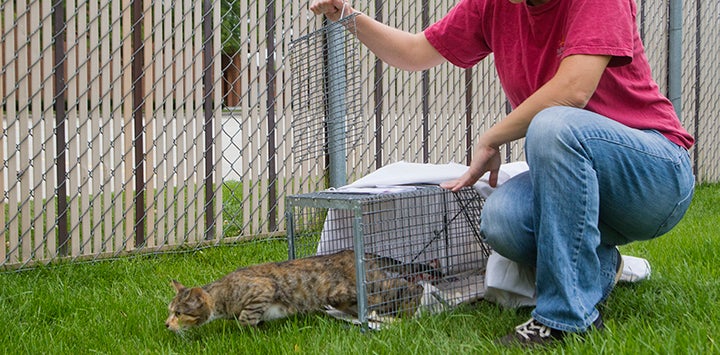
Trap-Neuter-Return Essentials
Thank you so much for being a Best Friends Network partner and for all that you do for the animals. With your hard work, together, we can save the lives of countless animals, including those most at risk in shelters — community cats.
Please check out the information below to learn more about trap-neuter-return (the most effective way to keep community cats safe and out of shelters) and how you can ensure that even more cats live happy, healthy lives.
Current reality
About two-thirds of the cats and kittens who enter our nation’s animal shelters each year don’t make it out alive. Most of those killed are free-roaming community cats and kittens.
Together, we can change that and Save Them All.
Trap-neuter-return
Trap-neuter-return (TNR) is the most humane, effective way to help reduce the number of community cats who live on our streets. With TNR, community cats are humanely trapped, vaccinated* and sterilized by licensed veterinarians before being returned to their outdoor homes. A few of the benefits of TNR are:
- Stabilized and even reduced population of community cats
- Improved public health and safety (e.g., vaccinations, fewer cats overall, etc.)
- Improved health of cats (e.g., reduced transmission of feline leukemia and feline immunodeficiency virus)
- Reduced nuisance complaints (please see below)
The Community Cats Projects (CCPs), a public-private partnership of Best Friends Animal Society, PetSmart Charities, Inc.™ and local municipalities, are high-volume, shelter-based programs that focus on specific zip codes and neighborhoods. And the CCPs have demonstrated that TNR has a truly lifesaving impact:
- In 2014, about 6,000 cats and kittens entered Albuquerque’s shelter system. That’s 39 percent fewer cats and kittens than in 2011, prior to the program’s start. And the number of cats and kittens who were killed decreased by 86 percent, from more than 3,400 in 2011 to 476 in 2014.
- In 2014, 26 percent fewer kittens under four months of age entered the Baltimore Animal Rescue and Care Shelter, compared to 2012. This is a strong indicator that the number of outdoor cats breeding in these communities is being reduced significantly.
- In San Antonio, where the number of cats and kittens entering shelters was rising dramatically before the program’s launch in April 2012, the intake of cats and kittens declined sharply by the end of 2014. And the number of cats killed during 2014 was 83 percent lower than in 2011, when more than 4,300 cats and kittens lost their lives in that city’s municipal shelter.
Kittens and adoptions
TNR is the only humane option for most community cats. However, kittens and friendly adult cats are often pulled from colonies when adoption opportunities are available. Groups focusing on TNR can expand their lifesaving work significantly by collaborating with local rescue groups to find homes for these cats. Please keep in mind, however, that rescuing them can sometimes put a strain on an organization’s resources.
Economics
Although no rigorous economic studies comparing TNR to the traditional trap-and-kill approach have been conducted, some key factors are well understood. For example, much of the work (e.g., trapping, transportation, feeding, etc.) associated with TNR programs is done by volunteers — people who are unwilling to contribute to lethal efforts. The costs of trap-and-kill programs fall on taxpayers, many of whom are opposed to such programs (please see “public opinion” below).
TNR programs also attract funding from private nonprofits and foundations.
Public opinion
Americans overwhelmingly prefer non-lethal methods of animal control — in particular, TNR. A national survey commissioned by Best Friends in 2014 found that one in three Americans favor TNR programs to trap-and-kill. The health and welfare of the cats (38 percent) and public health (31 percent) were the most important factors in their choice.
Nuisance complaints
Nuisance complaints about community cats are usually the result of behaviors related to mating (e.g., yowling, spraying, fighting, etc.). Sterilizing these cats resolves most of the complaints. And for those who simply do not want cats on their property, a number of humane deterrents are available, which can be an invaluable tool for TNR programs.
Public policy
To make TNR programs as effective as possible, it’s important that public policy be aligned with the values and goals of the programs. While it’s not necessary that local animal ordinances explicitly endorse TNR, it’s best if their provisions at least don’t hinder TNR efforts. Bans on feeding “stray” or “feral” cats, for example, discourage caregivers from feeding openly, making it difficult to properly manage (and sterilize) colonies. (These misguided policies are also nearly impossible to enforce.)
It’s also important that policies governing animal control agencies be closely aligned with the values and goals of TNR programs. Ideally, the only cats brought to shelters by enforcement officers are those who are unhealthy and/or injured. Healthy, ear-tipped cats should be brought to shelters only if it’s determined to be in their best interests, and if positive outcomes can be assured.
Thank you so much for all that you do for community cats and for animals everywhere. Together, we can Save Them All.
*Our program cats receive the rabies vaccine and FVRCP, sometimes called the “distemper vaccine,” which protects against feline viral rhinotracheitis, calicivirus, and panleukopenia (also known as feline distemper). Note: Other community cat programs may or may not administer these vaccines as standard practice.